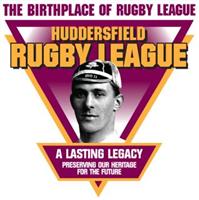Milestones In RL
Football was played by the Greeks and Romans in ancient times and was most likely introduced to the British Isles during Roman occupation. The game took the form of two teams who threw the ball in an attempt to carry it to the goal line at the opposite end of the pitch. This game survived in the Eastern counties of England through to the nineteenth century, perhaps owing to the heavy Roman presence in this area. Other forms of the game existed in other areas of the Country, such as "Hurling" which was popular in Cornwall.
1400-1800 - Many different types of football - rugby league’s ancestors - are played throughout Britain. Unlike modern soccer, most football games allowed handling the ball. There are records of football games being played in future league strongholds such as Hull, Huddersfield, Rochdale, Whitehaven, Workington and York.
Since the 1800s, the laws of both rugby codes had required a set scrum to be formed everytime a player was tackled to the ground or held (unable to pass the ball). Much of the game was consumed by scrummaging contests instead of open play.
1823 - William Webb Ellis, a pupil at Rugby School, allegedly picked up the ball and invented rugby. But there is no evidence to support this myth - even the 1895 Inquiry, which immortalised Ellis, found no proof. Running with the ball became common in 1830s at Rugby School and Rugby School football became popular throughout the UK in the 1850s and 1860s.
1864 - The first rugby clubs formed in Leeds and Huddersfield, followed by Hull (1865), York (1868), followed by hundreds more in Cumbria, Lancashire and Yorkshire in the 1870s and 1880s.
1876 - Yorkshire Cup competition started for Yorkshire rugby clubs. Soon it attracts bigger crowds than the FA Cup Final.
The first calls to reduce the number of players for each side were made under the RFU era, before the split of 1895. Support for the change was strongest amongst the Northern clubs, and the RFU decreed that anything less than 15-a-side amounted to professionalism - and therefore expulsion or suspension for any clubs and footballers involved.
1886 - Concerned at the growing dominance of the largely working-class northern clubs, the Rugby Football Union introduces strict amateur rules.
1893 - Yorkshire clubs propose allowing players to be paid six shillings ‘broken-time’payments when they miss work due to matches. RFU vote down proposal. Widespread suspensions of northern clubs and players begin.
1895 - Threatened with expulsion from the RFU if they cannot prove their amateurism, 21 leading Lancashire and Yorkshire clubs meet at the George Hotel, Huddersfield on 29 August 1895. They vote unanimously to form the Northern Rugby Football Union (NU) and allow broken-time payments. [The clubs and their year of foundation were: Batley 1880, Bradford 1863, Brighouse Rangers 1878, Broughton Rangers 1877, Dewsbury 1875, Halifax 1873, Huddersfield 1864, Hull 1865, Hunslet 1883, Leeds 1890, Leigh 1877, Liversedge 1877, Manningham 1876, Oldham 1876, Rochdale Hornets 1871, St Helens 1874, Tyldesley 1879, Wakefield Trinity 1873, Warrington 1875, Widnes 1873, Wigan 1879. Dewsbury withdrew a few days later and were replaced by Runcorn (1876). Stockport was also accepted by telephone at the meeting at The George. ]
1897 - To make the game more exciting, the NU abolishes the line-out and reduces value of all goals to two points. Tries worth three points.
Under the NU, trial matches saw various numerical combinations tried. County matches in the early 1900s were played with 12-a-side, as was the first ever International contest (England v Other Nationalities) in April 1904. At the same time, most "Work competitions" comprised clubs using 12-a-side teams.
1906 - Modern rugby league is born when the number of players is reduced from fifteen to thirteen a side. Rucks and mauls after a tackle replaced by the play-the-ball.
1908 - Hunslet win ‘All Four Cups’a grand slam of all competitions.
1909 -Maximum of three forwards in front row of the scrum; other rows remain unrestricted.
1914 - Huddersfield’s Albert Rosenfeld scores a record 80 tries in one season. British tourists defeat Australia 14-6 to win Ashes in final test, finishing with only ten men in what becomes known as ‘Rorke’s Drift’Test match.
1915 - Huddersfield, known as ‘The Team of all The Talents’, win all four cups, led by Harold Wagstaff. GLORY DAYS
1920 -Scrum half required to roll ball into scrum.
1922 -Goal from ‘fair catch/mark' and soccer-style ‘field goal' abolished.
1922 - Northern Union changes its name to the Rugby Football League.
1925 -A second football provided at the touch-line to eliminate delays during all first-class matches.
1926 -Goal-line drop-out (instead of from the 25-yard line) after defender makes ball dead; play-the-ball modernised - only marker and man playing the ball to be involved in contest for the ball, and marker to keep both feet on ground until ball is dropped or placed.
1927 - First radio broadcast of Challenge Cup final by the BBC.
1929 - First Challenge Cup Final to be played at Wembley - Wigan defeat Dewsbury 13-2 in front of 41,500.
1931 - Defending halfback to feed scrum (previously the attacking half-back fed scrum), with attacking side having the loose-head. The ‘3-2-1' scrum formation made mandatory. Scrums to be set minimum of 10 yards from touch and minimum of 5 yards from goal line. Off-side player at time of play-the-ball to be penalised if not making attempt to get on on-side and/or interferes/obstructs opposing player(s).
1932 - Hooker must have both arms over props (loose-arm rule); penalty extended to include optional scrum (instead of ‘free kick').
1933 - First rugby league club in London: London Highfield.
1948 - Front rows cannot pack against each other until ordered by referee.
1951 - Five-yard ruck rule introduced (for one season only) to both teams; previously there had been a ‘no-yard' ruck rule.
1952 - No-yard ruck rule reinstated; dummy-half and second-marker to both stand one yard behind the two men at the play-the-ball.
1954 - Tap penalty introduced, with offending team to retire 10 yards.
1956 - Three-yard ruck rule applied to both teams, with no minimum distance for dummy-half and second-marker.
1959 - Abolition of tap penalty.
1961 - Dummy-half caught with ball resulted in a scrum (rescinded after 1962 season).
1963 - Ball from scrum to come out from behind the second-rowers; non-offending team given feed and loose-head for scrum from penalties (including after kick to touch); teams can replace a maximum of two injured players up to and including halftime .
1964 - Substitutes allowed for the first time, but only for players injured before half-time.
1966 - Four tackle rule introduced, increased to six in 1972. Five-yard ruck rule implemented (applied to both teams i.e. attackers and defenders).
1967 - Professional Rugby League matches allowed on Sundays for the first time, although amateurs had played on Sundays since 1956.
1967 - Four-tackle rule replaced unlimited tackles; tap penalty reintroduced; scrum replaced by tap kick for restart after penalty kick into touch.
1968 - Restart after attacking team makes ball dead: 25-yard optional kick.
1969 - Front row to pack ‘square' in the scrums.
1970 - Two replacements for injured players allowed at any time during a game, provided those replacements had played at least half of a lower-grade game.
1971 - Value of drop goal reduced from two points to one, and six-tackle rule introduced.
1972 - Timekeepers and sirens introduced for first time.
1973 - Two divisions introduced permanently into Rugby League. The British Amateur Rugby League Association is formed in Huddersfield.
1974 - Drop goal reduced from two points to one point.
1981 - ‘Sin-bin' and differential scrum penalty introduced; four replacements allowed.
1982 - Scrum feed and loose-head given to non-offending team.
1983 - Try increased to four points, sin-bin introduced and handover after sixth tackle, instead of a scrum, begins.
1986 - Twenty-metre restart when ball caught on full in in-goal by defending team.
1987 - ‘Head-bin' introduced (players suffering minor head injuries allowed to return to the field of play after 10 minutes without affecting team's quota of replacements).
1989 - Handover if on the sixth tackle the attacking team knocks on, kicks out on the full, or runs into touch. At scrums, backs (apart from half-back) to stand back a minimum of 5m.
1990 - Blood-bin introduced.
1990 - In-goal touch judges used. Off-side kick chasers to remain 10m (increased from 5m) away from opponent taking possession of the ball.
1991 - Penalty against defender stripping the ball from opponent in possession (later changed to allow one-on-one strips). Interchange rule introduced, allowing a maximum of four players to be available for a total of six interchanges in a match. This rule was brought in primarily to cut down the risk of the spread of blood-borne diseases. Players sent to the ‘blood-bin' did not count among these six interchanges.
1993 - Ten-metre rule introduced mid-season.
1996 - First season of Super League, following 1995 RFL decision to switch to summer.
1997 - Striking in the play-the-ball banned; deletion of minimum distance for attacking team behind dummy-half; ‘40/20' kicking rule introduced; new guidelines introduced to combat ‘dangerous throws'.
1998 - ‘Zero tackle' introduced; video referee introduced.
1998 - Grand Final and play-offs introduced into Super League.
1999 - Drop goal still awarded even if touched in flight by defender.
2001 - Defending player jumping to take a catch from opponent's kick cannot be tackled mid-air. Team finding touch from the 20m optional re-start to feed scrum. If the defending team takes the ball dead from a kick (e.g. placing one foot over the dead ball line before playing at the ball) from anywhere on the field it must re-start play with a drop-out from beneath its own posts.
2007 - Limited interchange rule changed - 4 replacements and max. 12 interchanges.
2004 - When attacking player is held up in-goal, play-the-ball 10 metres from goal-line.
2009 - Penalty applied against defender where kicker is tackled whilst in the air.




